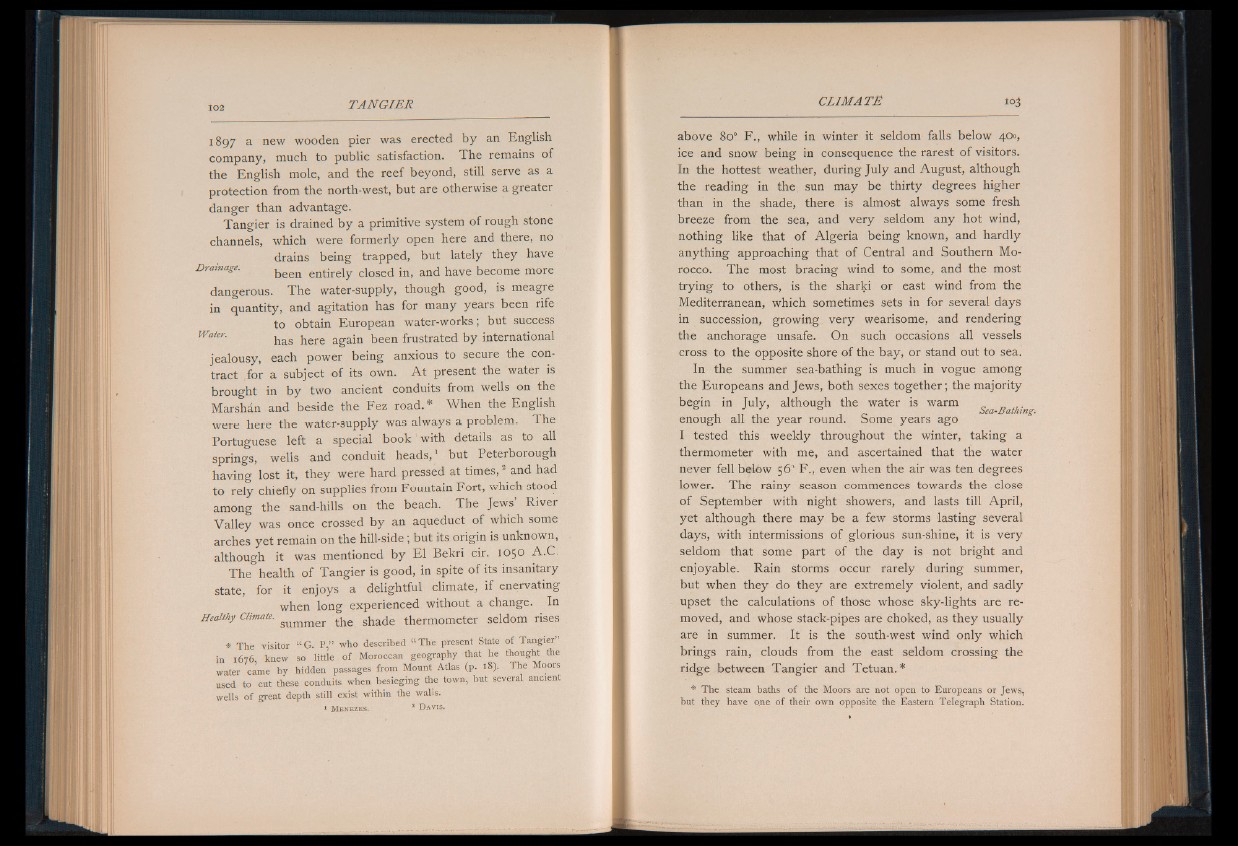
1897 a new wooden pier was erected by an English
company, much to public satisfaction. The remains of
the English mole, and the reef beyond, still serve as a
protection from the north-west, but are otherwise a greater
danger than advantage.
Tangier is drained by a primitive system of rough stone
channels, which were formerly open here and there, no
drains being trapped, but lately they have
Drainage. been entirely closed in, and have become more
dangerous. The water-supply, though good, is meagre
in quantity, and agitation has for many years been rife
to obtain European water-works; but success
WaUr' has here again been frustrated by international
jealousy, each power being anxious to secure the contract
for a subject of its own. A t present the water is
brought in by two ancient conduits from wells on the
Marshan and beside the Fez road.* When the English
were here the water-supply was always a problem. The
Portuguese left a special book with details as to all
springs, wells and conduit heads,1 but Peterborough
having lost it, they were hard pressed at times,2 and had
to rely chiefly on supplies from Fountain Fort, which stood
among the sand-hills on the beach. The Jews River
Valley was once crossed by an aqueduct of which some
arches yet remain on the hill-side; but its origin is unknown,
although it was mentioned by El Bekri cir. 1050 A.C.
The health of Tangier is good, in spite of its insanitary
state, for it enjoys a delightful climate, if enervating
when long experienced without a change. In
Healthy Climate. summer the shade thermometer seldom rises
* The visitor “ G. P,” who described “ The present State of Tangier’
in 1676, knew so little of Moroccan geography that he thought the
water came by hidden passages from Mount Adas (p. 18). The Moors
used to cut these conduits when besieging the town, but several ancient
wells of great depth still exist within the walls.
1 Menezes. 2 Davis.
above 8o° F., while in winter it seldom falls below 40»,
ice and snow being in consequence the rarest o f visitors.
In the hottest weather, during July and August, although
the reading in the sun may be thirty degrees higher
than in the shade, there is almost always some fresh
breeze from the sea, and very seldom any hot wind,
nothing like that of Algeria being known, and hardly
anything approaching that of Central and Southern Morocco.
The most bracing wind to some, and the most
trying to others, is the sharki or east wind from the
Mediterranean, which sometimes sets in for several days
in succession, growing, very wearisome, and rendering
the anchorage unsafe. On such occasions all vessels
cross to the opposite shore of the bay, or stand out to sea.
In the summer sea-bathing is much in vogue among
the Europeans and Jews, both sexes together; the majority
begin in July, although the water is warm
J c Sea-Bathing.
enough all the year round, borne years ago
I tested this weekly throughout the winter, taking a
thermometer with me, and ascertained that the water
never fell below 56’ F., even when the air was ten degrees
lower. The rainy season commences towards the close
of September with night showers, and lasts till April,
yet although there may be a few storms lasting several
days, with intermissions of glorious sun-shine, it is very
seldom that some part of the day is not bright and
enjoyable. Rain storms occur rarely during summer,
but when they do they are extremely violent, and sadly
upset the calculations o f those whose sky-lights are removed,
and whose stack-pipes are choked, as they usually
are in summer. It is the south-west wind only which
brings rain, clouds from the east seldom crossing the
ridge between Tangier and Tetuan. *
* The steam baths of the Moors are not open to Europeans or Jews,
but they have one of their own opposite the Eastern Telegraph Station.